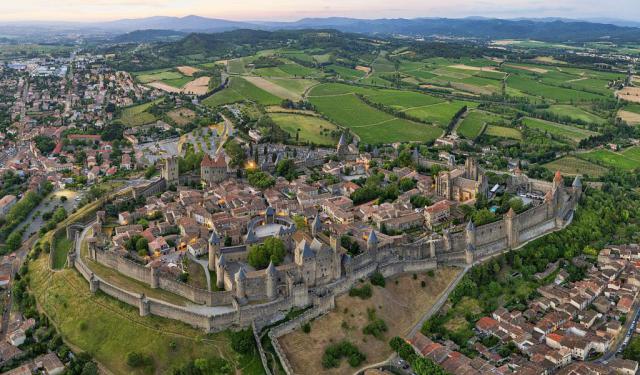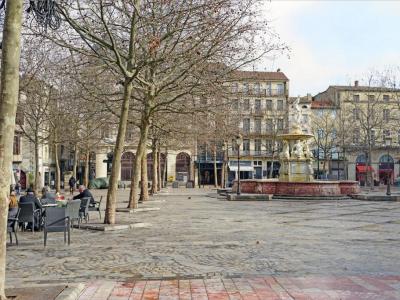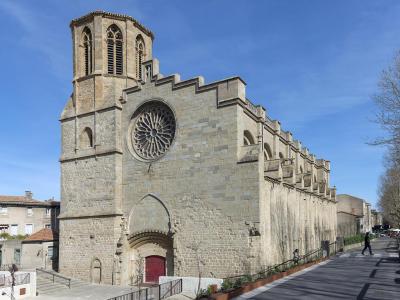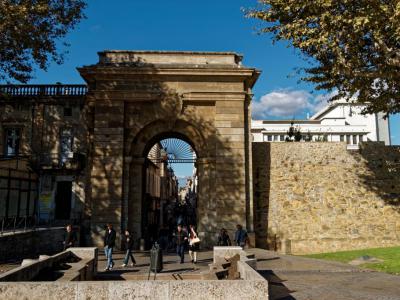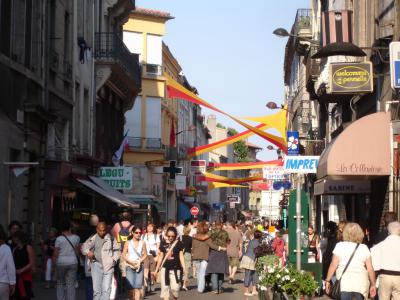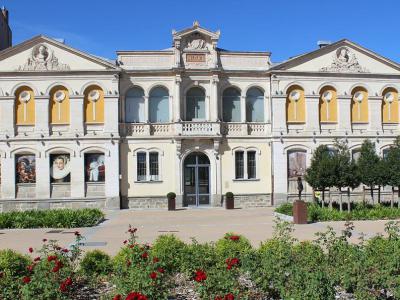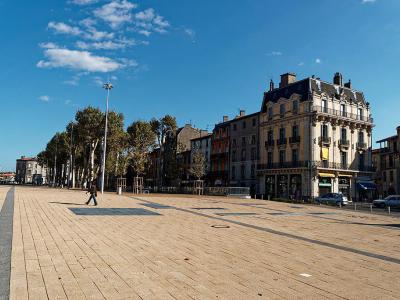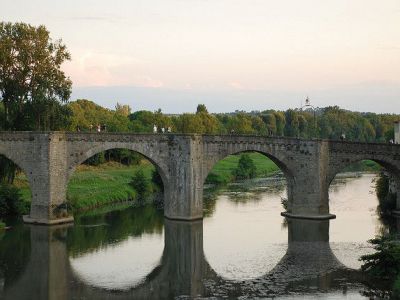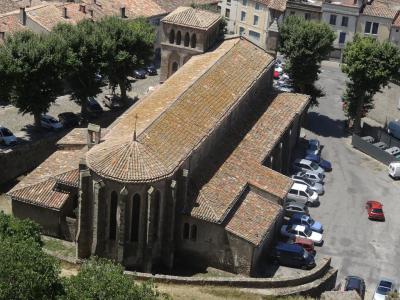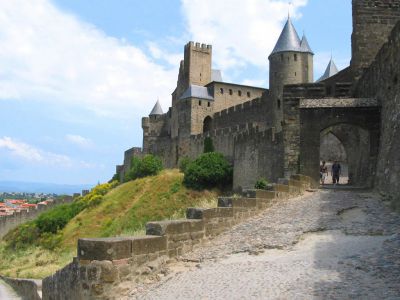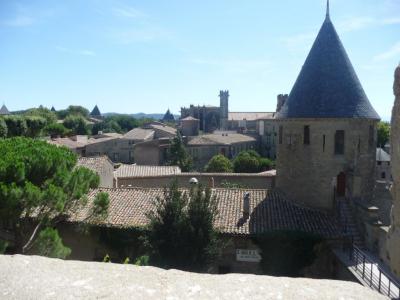Carcassonne Introduction Walking Tour (Self Guided), Carcassonne
Nestled in the picturesque region of Occitanie in southern France is the captivating city of Carcassonne.
The name "Carcassonne" is believed to have originated from the Gallic word "Carsac," referring to a fort settlement that was later fortified by the Romans who occupied the area in the 1st century BC.
A legend suggests another, more colorful version of the name, though. During the 8th-century wars between Christians and Muslims, Charlemagne's army besieged the town, then ruled by a Saracen princess named Carcas. During the siege, as supplies dwindled, the princess devised a ruse – ingeniously feeding the last wheat to a pig and then hurling it from the city's highest tower - she deceived the besiegers into thinking the city still had enough food.
Seeing this, Charlemagne lifted the siege. Overjoyed by the success of her plan, Lady Carcas sounded the city bells, upon which one of Charlemagne's men exclaimed: "Carcas sonne!" ("Carcas rings").
In the 9th century, Carcassonne became the capital of its namesake county under the Carolingian Empire. In 1240, an uprising led to the establishment of the Bastide, the "lower town" across the river, sparking a rivalry with the original Cité (fortified “upper town”). Despite challenges such as the plague and the Hundred Years' War, Bastide prospered as a textile hub. In 1247, it became part of the Kingdom of France.
With the Treaty of the Pyrenees in 1659, Cité's military role as a frontier between France and Spain ended. Its significance diminished further as institutions moved to the lower town, facing economic challenges exacerbated by competition and the French Revolution. In 1795–1800, Carcassonne absorbed Cité, consolidating its territory.
In 1997, the fortified Cité de Carcassonne gained UNESCO recognition, solidifying the city's status as a tourist destination.
One of its most iconic landmarks is the magnificent Gothic Carcassonne Cathedral. Another key attraction is Carnot Square (Place Carnot), a bustling hub of activity.
Seasoned travelers and tourists don't miss the chance to walk over the Old Bridge (Le Pont Vieux), providing a scenic vantage point overlooking the tranquil waters of the Aude River.
Also, visiting Carnot Square (Place Carnot), named for a hero of the French Revolution, is highly recommended while strolling on Verdon Street.
There's plenty to discover and enjoy in Carcassonne, from its storied history to architectural marvels to its vibrant cultural scene. So, come explore the enchanting streets and hidden treasures of this captivating city, where the past and present rings in a mesmerizing tune!
The name "Carcassonne" is believed to have originated from the Gallic word "Carsac," referring to a fort settlement that was later fortified by the Romans who occupied the area in the 1st century BC.
A legend suggests another, more colorful version of the name, though. During the 8th-century wars between Christians and Muslims, Charlemagne's army besieged the town, then ruled by a Saracen princess named Carcas. During the siege, as supplies dwindled, the princess devised a ruse – ingeniously feeding the last wheat to a pig and then hurling it from the city's highest tower - she deceived the besiegers into thinking the city still had enough food.
Seeing this, Charlemagne lifted the siege. Overjoyed by the success of her plan, Lady Carcas sounded the city bells, upon which one of Charlemagne's men exclaimed: "Carcas sonne!" ("Carcas rings").
In the 9th century, Carcassonne became the capital of its namesake county under the Carolingian Empire. In 1240, an uprising led to the establishment of the Bastide, the "lower town" across the river, sparking a rivalry with the original Cité (fortified “upper town”). Despite challenges such as the plague and the Hundred Years' War, Bastide prospered as a textile hub. In 1247, it became part of the Kingdom of France.
With the Treaty of the Pyrenees in 1659, Cité's military role as a frontier between France and Spain ended. Its significance diminished further as institutions moved to the lower town, facing economic challenges exacerbated by competition and the French Revolution. In 1795–1800, Carcassonne absorbed Cité, consolidating its territory.
In 1997, the fortified Cité de Carcassonne gained UNESCO recognition, solidifying the city's status as a tourist destination.
One of its most iconic landmarks is the magnificent Gothic Carcassonne Cathedral. Another key attraction is Carnot Square (Place Carnot), a bustling hub of activity.
Seasoned travelers and tourists don't miss the chance to walk over the Old Bridge (Le Pont Vieux), providing a scenic vantage point overlooking the tranquil waters of the Aude River.
Also, visiting Carnot Square (Place Carnot), named for a hero of the French Revolution, is highly recommended while strolling on Verdon Street.
There's plenty to discover and enjoy in Carcassonne, from its storied history to architectural marvels to its vibrant cultural scene. So, come explore the enchanting streets and hidden treasures of this captivating city, where the past and present rings in a mesmerizing tune!
How it works: Download the app "GPSmyCity: Walks in 1K+ Cities" from Apple App Store or Google Play Store to your mobile phone or tablet. The app turns your mobile device into a personal tour guide and its built-in GPS navigation functions guide you from one tour stop to next. The app works offline, so no data plan is needed when traveling abroad.
Carcassonne Introduction Walking Tour Map
Guide Name: Carcassonne Introduction Walking Tour
Guide Location: France » Carcassonne (See other walking tours in Carcassonne)
Guide Type: Self-guided Walking Tour (Sightseeing)
# of Attractions: 10
Tour Duration: 2 Hour(s)
Travel Distance: 2.5 Km or 1.6 Miles
Author: Linda
Sight(s) Featured in This Guide:
Guide Location: France » Carcassonne (See other walking tours in Carcassonne)
Guide Type: Self-guided Walking Tour (Sightseeing)
# of Attractions: 10
Tour Duration: 2 Hour(s)
Travel Distance: 2.5 Km or 1.6 Miles
Author: Linda
Sight(s) Featured in This Guide:
- Place Carnot (Carnot Square)
- Carcassonne Cathedral
- Porte Monumentale des Jacobins (Jacobins Monumental Gate)
- Rue Verdun (Verdun Street)
- Musée des Beaux-Arts (Fine Arts Museum)
- Place Gambetta (Gambetta Square)
- Le Pont Vieux (Old Bridge)
- Eglise Saint-Gimer (Saint-Gimer Church)
- Porte de l'Aude (Aude Gate)
- Cité de Carcassonne (Fortified City of Carcassonne)
1) Place Carnot (Carnot Square) (must see)
In 1355 royal surveyors laid out a large square in Carcassonne, France. The square can be found today at the junction of rue de Verdun and rue Georges Clemenceau.
Throughout its existence, the square has had a variety of names. It has been called Louis XVI Square, Louis XVIII Square, Freedom Square, Republic Square, Napoleon Square and Perrache Square. Finally, in 1889, it is Carnot Square.
Lazare Carnot was a hero of the French revolution. He was a mathematician, military engineer and a politician closely associated with both Robespierre and Napoleon Bonaparte. In the assembly he was not radical. He sat between the extremist Jacobins and the more conservative Girondins. He seemed neither Meat nor Dairy.
The square is paved with stones. At the center of the square is The Fountain of Neptune. It is a sculpture of the god standing on a plate supported by nymphs standing on a pedestal sitting in a round pond. Dolphins spray water into the pond. The sculpture is by Italian artists Barata and son.
Every Tuesday, Thursday and Saturday there is an open air market in the square. There are outdoor cafe tables where one can sit and enjoy a coffee and pastis while watching people, children and pigeons. As the time passes, imagine the square as a place of executions, fighting and fairs. It has been all these things.
Throughout its existence, the square has had a variety of names. It has been called Louis XVI Square, Louis XVIII Square, Freedom Square, Republic Square, Napoleon Square and Perrache Square. Finally, in 1889, it is Carnot Square.
Lazare Carnot was a hero of the French revolution. He was a mathematician, military engineer and a politician closely associated with both Robespierre and Napoleon Bonaparte. In the assembly he was not radical. He sat between the extremist Jacobins and the more conservative Girondins. He seemed neither Meat nor Dairy.
The square is paved with stones. At the center of the square is The Fountain of Neptune. It is a sculpture of the god standing on a plate supported by nymphs standing on a pedestal sitting in a round pond. Dolphins spray water into the pond. The sculpture is by Italian artists Barata and son.
Every Tuesday, Thursday and Saturday there is an open air market in the square. There are outdoor cafe tables where one can sit and enjoy a coffee and pastis while watching people, children and pigeons. As the time passes, imagine the square as a place of executions, fighting and fairs. It has been all these things.
2) Carcassonne Cathedral (must see)
Built in the thirteenth century, the cathedral originally was a church dedicated to Saint Michael. In the fourteenth century it was so heavily damaged after a visit by the Black Prince of Wales in the Hundred Years' War it was decided to rebuild it as a fortified church.
The cathedral's interior is massive. It has a nave of eight bays with side chapels. The choir is pierced with arched stained glass windows. The ceiling is very high. There are small round stained glass windows near the top of the vault. When the sun is caught by the windows the interior acquires a soft glow.
Two side aisles on either side of the nave are supported alternatively by round and square columns. The ogival Gothic transept and vaults by Pieree de Rochefort show a distinct Scandinavian influence.
In 1803 the church was designated a cathedral to replace the pre-revolutionary cathedral dedicated to Saints Nazarius and Celsus.
The cathedral's interior is massive. It has a nave of eight bays with side chapels. The choir is pierced with arched stained glass windows. The ceiling is very high. There are small round stained glass windows near the top of the vault. When the sun is caught by the windows the interior acquires a soft glow.
Two side aisles on either side of the nave are supported alternatively by round and square columns. The ogival Gothic transept and vaults by Pieree de Rochefort show a distinct Scandinavian influence.
In 1803 the church was designated a cathedral to replace the pre-revolutionary cathedral dedicated to Saints Nazarius and Celsus.
3) Porte Monumentale des Jacobins (Jacobins Monumental Gate)
One of the four gates opened in the walls of Carcassonne in the years 1355 to 1359, the Saint Louis Gate was rebuilt in 1779 as the Jacobins Monumental Gate. The royal badges and shields were removed in the process of rebuilding. The Jacobins Monumental Gate is all that remains of the original four gates to the lower city.
What about the badges and shields and other adornments that were removed in 1779? What are we missing and why? In 1778 four projects for the gates of the city were submitted to the mayor. Mayor Dupre favored the plans submitted by M. Dalbeau, an architect and City Inspector. In 1779, for 400 pounds, Sieur Parant, sculptor, set to work.
The work was destruction, unusual for the sculptor but for the money, ok. The outer escutcheon of the King's arms was ten feet high and nine feet wide. It bore the cordons of Saint-Louis and Saint-Michel the frame was fashioned with laurel branches. The inner escutcheon was smaller with the arms of the city and more laurels. All gone now.
Why? It might be thought that signs of royalty were anathema in the Revolution but the Revolution and its effects were yet to come. It is more likely Mr. Dalbeau and the Mayor were simply caught up in the fever of re-doing the old and bringing in the new.
The gate opens up to the old medieval city. One leaves a pleasant square with fountains and cafes and enters the narrow cobblestone byways of the middle ages. A dream-like experience.
What about the badges and shields and other adornments that were removed in 1779? What are we missing and why? In 1778 four projects for the gates of the city were submitted to the mayor. Mayor Dupre favored the plans submitted by M. Dalbeau, an architect and City Inspector. In 1779, for 400 pounds, Sieur Parant, sculptor, set to work.
The work was destruction, unusual for the sculptor but for the money, ok. The outer escutcheon of the King's arms was ten feet high and nine feet wide. It bore the cordons of Saint-Louis and Saint-Michel the frame was fashioned with laurel branches. The inner escutcheon was smaller with the arms of the city and more laurels. All gone now.
Why? It might be thought that signs of royalty were anathema in the Revolution but the Revolution and its effects were yet to come. It is more likely Mr. Dalbeau and the Mayor were simply caught up in the fever of re-doing the old and bringing in the new.
The gate opens up to the old medieval city. One leaves a pleasant square with fountains and cafes and enters the narrow cobblestone byways of the middle ages. A dream-like experience.
4) Rue Verdun (Verdun Street)
Verdun Street in Carcassonne touches Carnot Square in the Cite (the old town) and extends into the Bastide (the lower, modern town). In both areas of Carcassonne there is great shopping on Verdun Street.
There are various shops and cafes all along the street and there is a weekly food market that takes place on Tuesday, Thursday and Saturday.
Shops accessible on the rue Verdun include: Maison Juliette, a bakery and patisserie; La Ferme, "fine grocery store"; and other emporiums for food, wines, flatware and cookery. There is a bountiful amount of retailers, book shops and book stalls, stationeries and souvenir and novelty shops. There are lots of gift shops, cheese shops, art galleries and malls.
All these are in the fortified Cite or the Bastide Saint-Louis (lower town). While the Cite is basically barred to auto traffic, there is driving in the lower town. One may stroll from shop to shop in a neighborhood from the 12th century. Or, one may choose to navigate the busier, crowded streets of the Bastide. It's plentiful and good either way.
There are various shops and cafes all along the street and there is a weekly food market that takes place on Tuesday, Thursday and Saturday.
Shops accessible on the rue Verdun include: Maison Juliette, a bakery and patisserie; La Ferme, "fine grocery store"; and other emporiums for food, wines, flatware and cookery. There is a bountiful amount of retailers, book shops and book stalls, stationeries and souvenir and novelty shops. There are lots of gift shops, cheese shops, art galleries and malls.
All these are in the fortified Cite or the Bastide Saint-Louis (lower town). While the Cite is basically barred to auto traffic, there is driving in the lower town. One may stroll from shop to shop in a neighborhood from the 12th century. Or, one may choose to navigate the busier, crowded streets of the Bastide. It's plentiful and good either way.
5) Musée des Beaux-Arts (Fine Arts Museum)
The Fine Arts Museum can be found in the Bastide Saint-Louis section of the city of Carcassonne. The museum was founded in 1836 in the old presidial court of the city. The impetus for the museum was provided by a group describing themselves as "passionate about art, history and archeology." The facade was restored completely in 1900.
The collection of art housed by the museum is vast. There are 102 paintings from Society of Arts and Sciences (1845), donations from the State, private donors, and the Regional Museum Acquisition Fund. It also has a respectable archeological collection controlled by the Center for National Monuments.
It holds temporary exhibitions annually in cooperation with other museums and some galleries. There are around ten conferences on art history each year and student workshops at all levels up to university.
The museum consists of eleven rooms showing art by respective period. Rooms one, two and three contain French, Italian and Austrian paintings of the sixteenth through the early nineteenth centuries. Rooms four, five and six hold the Napoleonic era art and art of the French and English schools and ceramics.
Dutch and Flemish schools and neo-impressionism are found in rooms seven and eight. Rooms nine and ten are of the twentieth and twenty-first centuries. They cover the era between the world wars and the School of Paris. Room eleven holds some temporary exhibitions.
The collection of art housed by the museum is vast. There are 102 paintings from Society of Arts and Sciences (1845), donations from the State, private donors, and the Regional Museum Acquisition Fund. It also has a respectable archeological collection controlled by the Center for National Monuments.
It holds temporary exhibitions annually in cooperation with other museums and some galleries. There are around ten conferences on art history each year and student workshops at all levels up to university.
The museum consists of eleven rooms showing art by respective period. Rooms one, two and three contain French, Italian and Austrian paintings of the sixteenth through the early nineteenth centuries. Rooms four, five and six hold the Napoleonic era art and art of the French and English schools and ceramics.
Dutch and Flemish schools and neo-impressionism are found in rooms seven and eight. Rooms nine and ten are of the twentieth and twenty-first centuries. They cover the era between the world wars and the School of Paris. Room eleven holds some temporary exhibitions.
6) Place Gambetta (Gambetta Square)
Dutch philosopher Erasmus once said, "In the land of the Blind, the one-eyed man is king." Leon Gambetta had only one eye and he died relatively young. But he saw things more clearly than many of his fellow countrymen. An enemy of Monarchism and a brilliant orator, he declared the Republic on the fall of Napoleon III. He died at 44 in 1883.
So, today, in Carcassonne, in his honor, is the Gambetta Square. It is a large space, wide and elongated. It is lined with tall shade trees. There is a wide center mall planted with shrubs and flowers. There are benches to sit and modern sculptures to look at. The square is bounded by attractive buildings, including the Museum of Modern Art.
There are fountains and a shallow wading pool for children. A Tricolour flies over the World War II memorial at one end of the square. Under the square is a car park. Park here and be in easy walking distance of the old city. There are food and drink kiosks in the square for a refreshing snack and a break from touring.
So, today, in Carcassonne, in his honor, is the Gambetta Square. It is a large space, wide and elongated. It is lined with tall shade trees. There is a wide center mall planted with shrubs and flowers. There are benches to sit and modern sculptures to look at. The square is bounded by attractive buildings, including the Museum of Modern Art.
There are fountains and a shallow wading pool for children. A Tricolour flies over the World War II memorial at one end of the square. Under the square is a car park. Park here and be in easy walking distance of the old city. There are food and drink kiosks in the square for a refreshing snack and a break from touring.
7) Le Pont Vieux (Old Bridge) (must see)
Carcassonne is two cities. There is the Cite and the lower town. The two sections were connected by a bridge divided in two. A stone arch with cutwaters in front and rear marked the boundary between the two factions of Carcassonne. When disagreements became clashes, peace treaties were signed here.
The stone bridge replaced an earlier wooden span that had crossed upstream. The new stone bridge was finished in 1320. There are twelve arches on the bridge. The arches have unequal dimensions. The diameters of the arch openings vary from 33 to 46 feet. The arches were apparently built only as funds appeared, so it took a while to build the bridge
Since 1320 there was little change in the form of the bridge. Two arches collapsed in 1436 and were repaired. Other portions were modified in 1559, but there was no major change until 1820. In 1999 the City of Carcassonne and the Architects at Monuments of France rehabilitated the eastern end of the bridge and the access to Trivalle Street.
The Old Bridge is only for pedestrians. It is 739 feet long. It is closest to the medieval fortified city, a very pleasant walk.
The stone bridge replaced an earlier wooden span that had crossed upstream. The new stone bridge was finished in 1320. There are twelve arches on the bridge. The arches have unequal dimensions. The diameters of the arch openings vary from 33 to 46 feet. The arches were apparently built only as funds appeared, so it took a while to build the bridge
Since 1320 there was little change in the form of the bridge. Two arches collapsed in 1436 and were repaired. Other portions were modified in 1559, but there was no major change until 1820. In 1999 the City of Carcassonne and the Architects at Monuments of France rehabilitated the eastern end of the bridge and the access to Trivalle Street.
The Old Bridge is only for pedestrians. It is 739 feet long. It is closest to the medieval fortified city, a very pleasant walk.
8) Eglise Saint-Gimer (Saint-Gimer Church)
Saint Gimer was bishop of Carcassonne from 902 to 931. Gimer got his start by cornering the miracle bread business at an early age. He would purloin the bread his mother made, sell it, and give the sale proceeds to the poor. The miracle was that no matter how much bread he took from her, she always had the same amount of bread. A boy this good is destined to become a saint or even a bishop.
The Gothic Church of Saint-Gimer reflects the vision of its famous architect, Eugene Viollet-le-Duc. He married Northern Gothic style with the southern style. "Gothic architecture has all the advantages,..." He said, "...at once national, rational, and logical." The church has a nave and two aisles and a polygonal apse stationed on two vestries, all preceded by a porch. Le-Duc was active in the restoration three churches in the city.
His vision for Saint-Gimer was a simple parish church in his neo-Gothic style. Saint Gimer has been classified, like the town of Carcassonne, as protected in UNESCO's list of World Heritage sites.
The Gothic Church of Saint-Gimer reflects the vision of its famous architect, Eugene Viollet-le-Duc. He married Northern Gothic style with the southern style. "Gothic architecture has all the advantages,..." He said, "...at once national, rational, and logical." The church has a nave and two aisles and a polygonal apse stationed on two vestries, all preceded by a porch. Le-Duc was active in the restoration three churches in the city.
His vision for Saint-Gimer was a simple parish church in his neo-Gothic style. Saint Gimer has been classified, like the town of Carcassonne, as protected in UNESCO's list of World Heritage sites.
9) Porte de l'Aude (Aude Gate) (must see)
Partially destroyed in 1816 to make room for the Saint Gimer church, the ramp and crenelated walls of this gate remain overlooking the river Aude. The gate has been used as a locale for several "period" films, including The Visitors, Robin Hood, Prince of Thieves and Le Corniaud.
The Aude Gate, once called the Gate of Toulouse, pierced the Visigothic wall in the 12th century. The semicircular arch on the outside looks to be from this era, particularly with reference to its appearance and material used in construction.
The ramp is dominated by two towers. The intruder was forced to turn sharply to reach the Gate. In front of the gate there was no bridge or ditch to protect attackers. The space was untenable for an enemy. It was basically an armed trap, controlled on all sides from above.
Aude Gate is more impressive as an entrance to the Cite than other gates. It is at the peak of a steep path not open to traffic. It requires a rather steep climb but it is more tranquil than the usual tourist entry points.
The Aude Gate, once called the Gate of Toulouse, pierced the Visigothic wall in the 12th century. The semicircular arch on the outside looks to be from this era, particularly with reference to its appearance and material used in construction.
The ramp is dominated by two towers. The intruder was forced to turn sharply to reach the Gate. In front of the gate there was no bridge or ditch to protect attackers. The space was untenable for an enemy. It was basically an armed trap, controlled on all sides from above.
Aude Gate is more impressive as an entrance to the Cite than other gates. It is at the peak of a steep path not open to traffic. It requires a rather steep climb but it is more tranquil than the usual tourist entry points.
10) Cité de Carcassonne (Fortified City of Carcassonne) (must see)
For almost all of its history, the fortified City of Carcassonne has been defended by its walls. The Cite itself goes back more than 2,000 years. It was an oppidum, a Celtic iron age strong point. In the 1st century BCE the Romans transformed it into a town. The Romans were followed by Visigoths, Omayyads and eventually, Crusaders.
In 1208 Pope Innocent III declared a crusade against the Albegensian Heresy. This was bad news for Cathar Raimond-Roger, Viscount of Trencavel and ruler of Carcassonne. The Cathars were evicted and Raimond died in his own donjon. In 1247 Louis VIII declared the Cite to be royal after the usual terror, massacres and yes, the Inquisition.
The Roman walls were gradually replaced by the 14th century. New walls were reinforced and lengthened and new towers built. In 1459 however, The treaty of the Pyrenees was signed with Spain. Carcassonne ceased to be an important military outpost and the fortifications fell into disrepair.
In 1849 the Government in Paris tried to demolish the fortifications in a deluded effort at urban renewal. This proved unpopular. After a public outrage the government reversed itself and restoration of the Cite began in 1853.
Cue in M. Eugene Viollet-le-Duc, architect extraordinary in France in the 19th century. Le-Duc was charged with restoring the fortifications of Carcassonne. He came with an impressive resume. The Notre-Dame de Paris Cathedral, Basilica of Saint Francis, and Mont Saint Michel were all restored by his efforts.
Le-Duc was criticized for mixing northern and southern Gothic styles in his Gothic restorations. He used Blue tiles common in Flanders for the roofs of the towers of Carcassonne. His roofs were also pointed. The southern style used terra-cotta tiles and sloped roofs in the Roman fashion. In any case his walls and towers are more dramatic.
According to the legend, in the 8th century a Muslim princess of Carcassonne deceived Charlemagns into abandoning his siege of the city. As they marched away, she ordered all the bells to be rung. On hearing the bells the soldiers said, "Carcas sonne!" meaning "Carcas is ringing". Hence the name of the city.
Why You Should Visit:
Although Carcassonne has grown somewhat touristy in recent years, the old city remains the same. The restorations have made the fortifications and towers overwhelming. Something like Disneyland but Carcassonne is the real thing. And then there is the irreplaceable Jean Deschamps Theatre.
In 1208 Pope Innocent III declared a crusade against the Albegensian Heresy. This was bad news for Cathar Raimond-Roger, Viscount of Trencavel and ruler of Carcassonne. The Cathars were evicted and Raimond died in his own donjon. In 1247 Louis VIII declared the Cite to be royal after the usual terror, massacres and yes, the Inquisition.
The Roman walls were gradually replaced by the 14th century. New walls were reinforced and lengthened and new towers built. In 1459 however, The treaty of the Pyrenees was signed with Spain. Carcassonne ceased to be an important military outpost and the fortifications fell into disrepair.
In 1849 the Government in Paris tried to demolish the fortifications in a deluded effort at urban renewal. This proved unpopular. After a public outrage the government reversed itself and restoration of the Cite began in 1853.
Cue in M. Eugene Viollet-le-Duc, architect extraordinary in France in the 19th century. Le-Duc was charged with restoring the fortifications of Carcassonne. He came with an impressive resume. The Notre-Dame de Paris Cathedral, Basilica of Saint Francis, and Mont Saint Michel were all restored by his efforts.
Le-Duc was criticized for mixing northern and southern Gothic styles in his Gothic restorations. He used Blue tiles common in Flanders for the roofs of the towers of Carcassonne. His roofs were also pointed. The southern style used terra-cotta tiles and sloped roofs in the Roman fashion. In any case his walls and towers are more dramatic.
According to the legend, in the 8th century a Muslim princess of Carcassonne deceived Charlemagns into abandoning his siege of the city. As they marched away, she ordered all the bells to be rung. On hearing the bells the soldiers said, "Carcas sonne!" meaning "Carcas is ringing". Hence the name of the city.
Why You Should Visit:
Although Carcassonne has grown somewhat touristy in recent years, the old city remains the same. The restorations have made the fortifications and towers overwhelming. Something like Disneyland but Carcassonne is the real thing. And then there is the irreplaceable Jean Deschamps Theatre.
Walking Tours in Carcassonne, France
Create Your Own Walk in Carcassonne
Creating your own self-guided walk in Carcassonne is easy and fun. Choose the city attractions that you want to see and a walk route map will be created just for you. You can even set your hotel as the start point of the walk.
Medieval City of Carcassonne Walking Tour
A pig full of wheat was thrown off the battlements. The lady commanding the fortress was a Muslim. The besieging Christians knew Muslims do not eat pig. What is more, the defenders must have plenty of food if they could feed wheat to a pig and throw it over the walls. The siege had lasted five years. The attackers were starving. They left.
Many stories are told about the fortified medieval... view more
Tour Duration: 1 Hour(s)
Travel Distance: 1.2 Km or 0.7 Miles
Many stories are told about the fortified medieval... view more
Tour Duration: 1 Hour(s)
Travel Distance: 1.2 Km or 0.7 Miles
The Most Popular Cities
/ view all
